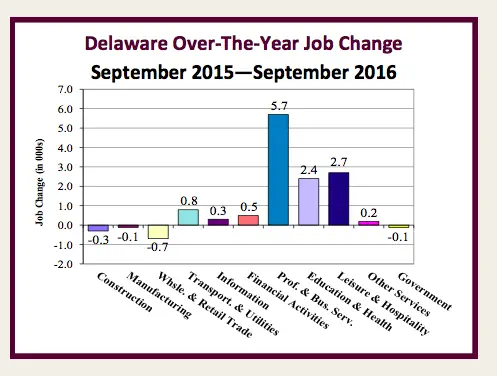Has Delaware hit the ceiling when it comes to the unemployment rate?
It could be possible based on September figures that show three consecutive months of a 4.3 percent rate.
The Delaware Department of Labor released the jobless rates and monthly information on Friday.
The Labor Department reported 20,700 unemployed Delawareans in September 2016 compared to 22,900 in September 2015.
The nation’s unemployment rate was 5 percent in September 2016, up from 4.9 percent in August 2016.
In September 2015 the U.S. unemployment rate was 5.1 percent, while Delaware’s rate was 4.9 percent.
In September 2016, seasonally adjusted nonfarm employment was 462,500 up from 460,300 in August 2016.
Since September 2015, Delaware’s total nonfarm jobs have increased by a net gain of 11,400, an increase of 2.5 percent. Nationally, jobs during that period increased 1.7%.
The commentary accompanying the job figures stated that “with Delaware’s unemployment rate remaining at 4.3 percent for the third consecutive month, evidence continues to mount that the state is near or at full employment.”
The 4.3 percent rate stands in contrast to unemployment rates in the mid-to-high three percent range.
“If that is the case, then future employment gains will come more from natural growth in the labor force and less from getting displaced workers back into jobs, or having discouraged workers return to the labor force,” the department noted.
Among the 14 gender and age groups tracked by the department, labor force participation is currently above the 2000-2015 average for 10 categories.
Only teenagers, males 20-24 years old, and women 65 and older are below the long-term averages.
September is the first month since February 2014 that the 12-month, over-the-year gain in the number of employed state residents fell below 10,000.
The report also noted that the median duration of unemployment is now 12.9 weeks, down from 14.4 at the beginning of the year and a peak of 24.5 weeks in 2010.
There have been concerns that discouraged or displaced workers are not planning to return to the workforce.
Age can play a role as many jobs simply put too many physical and mental demands on older workers.
Another factor is the so-called “gig economy” that has more workers in free-lance or contract positions with fewer benefits.




